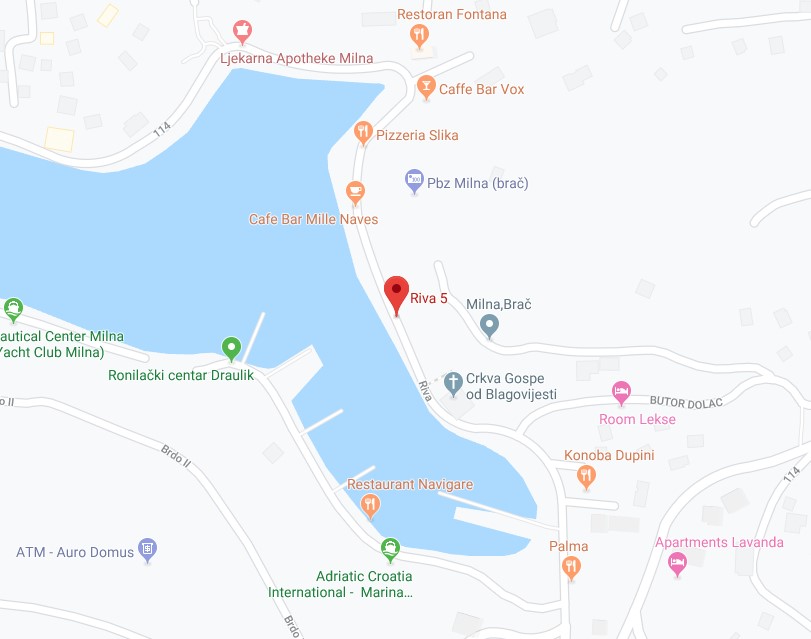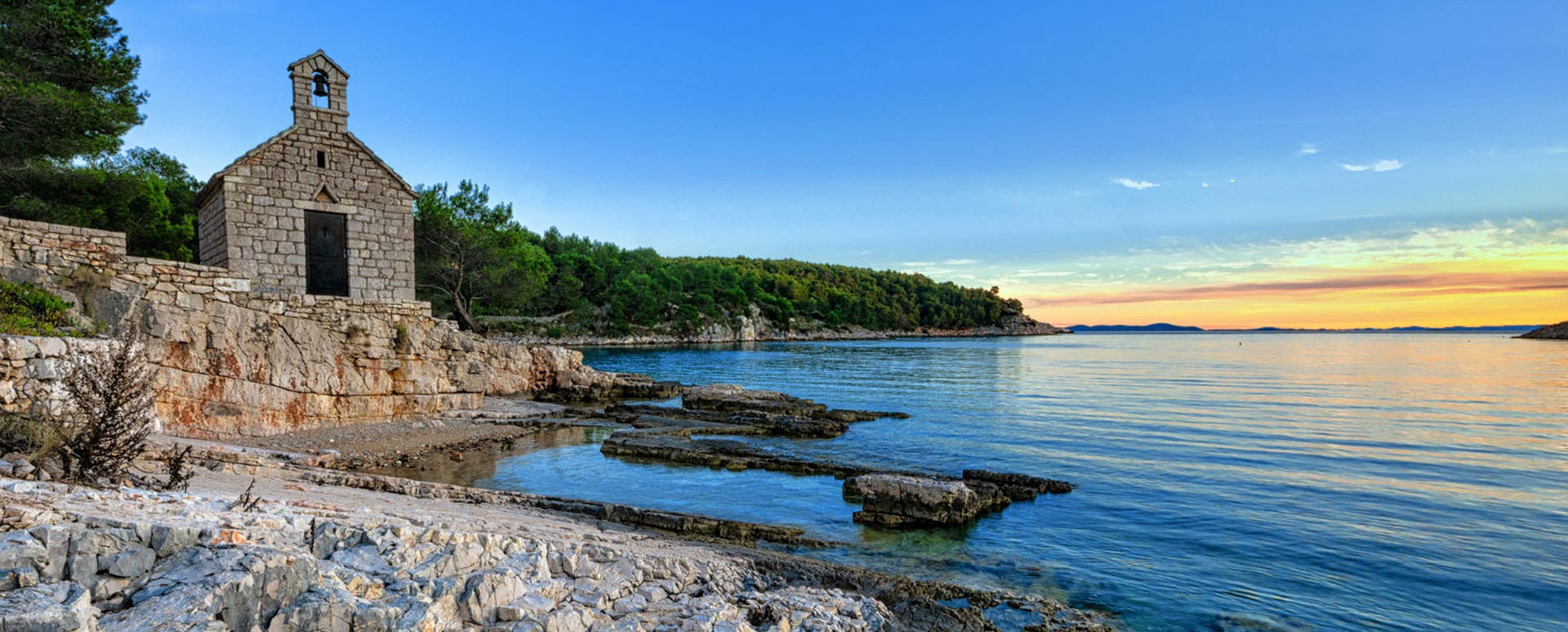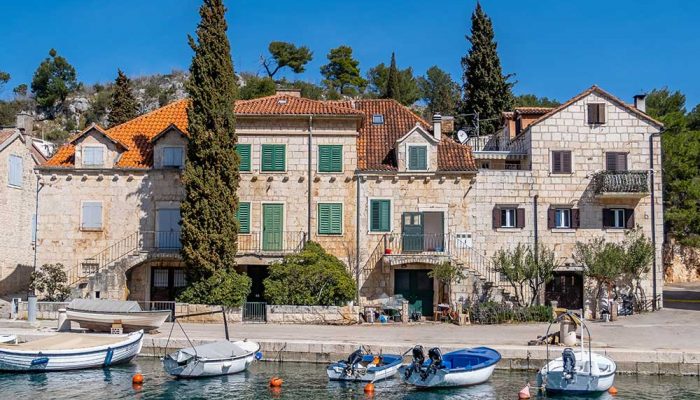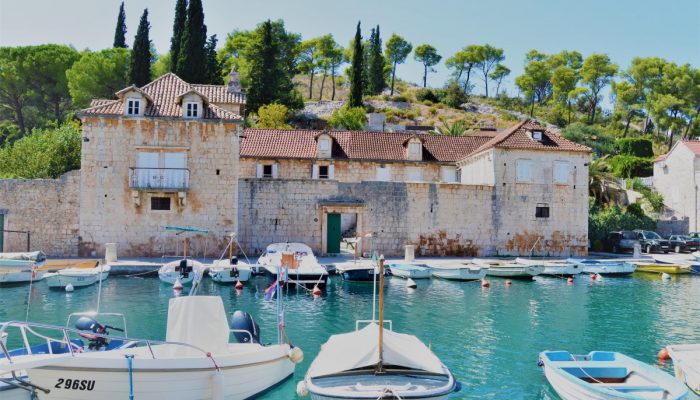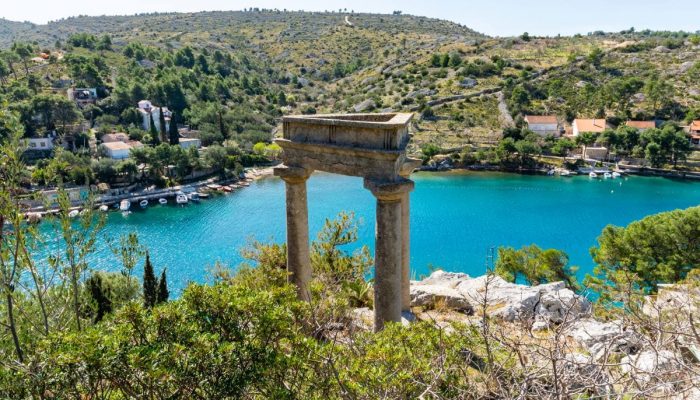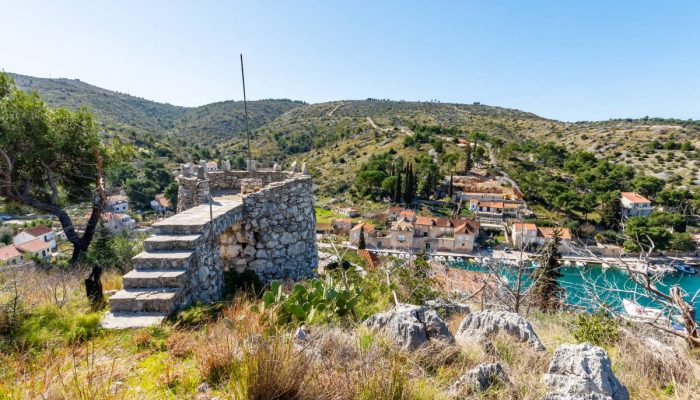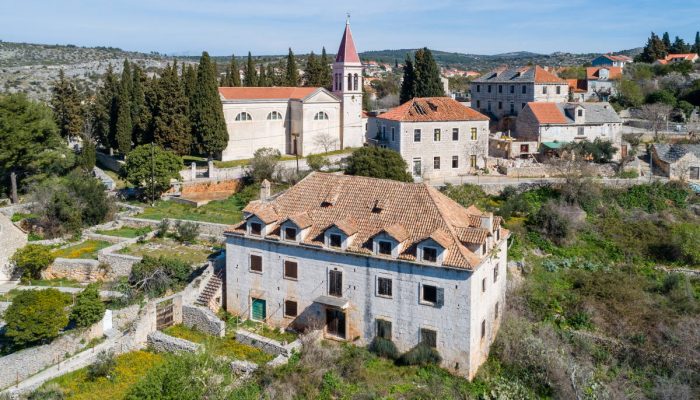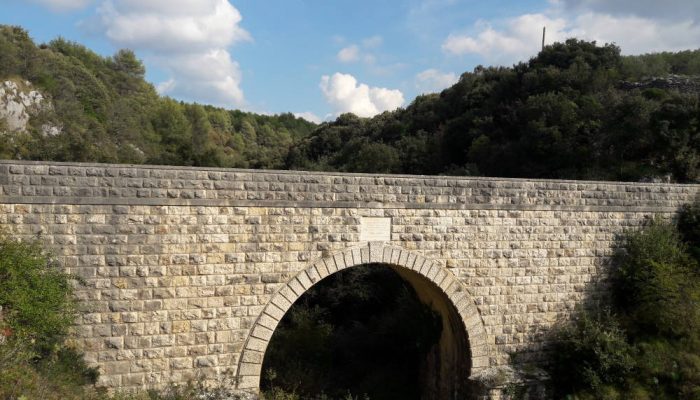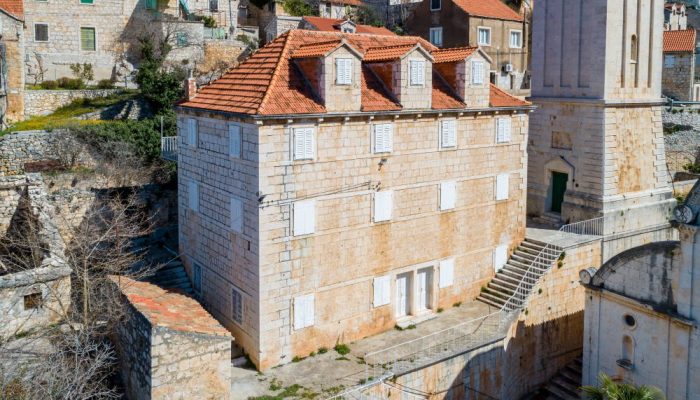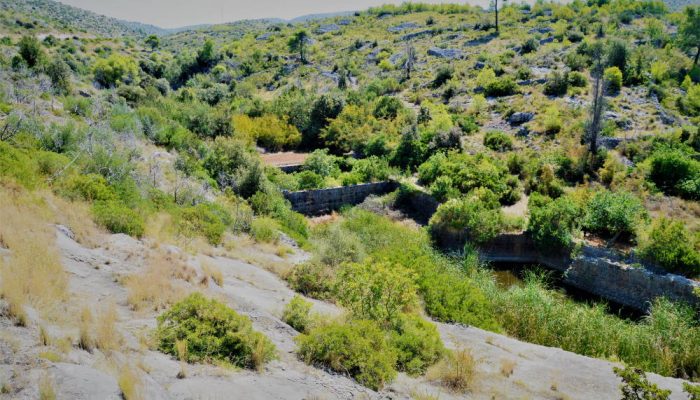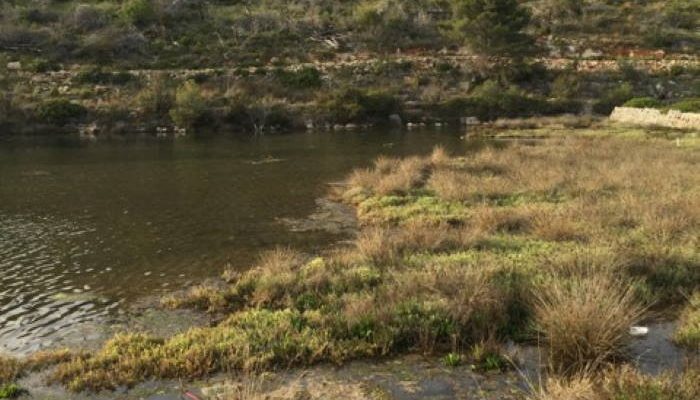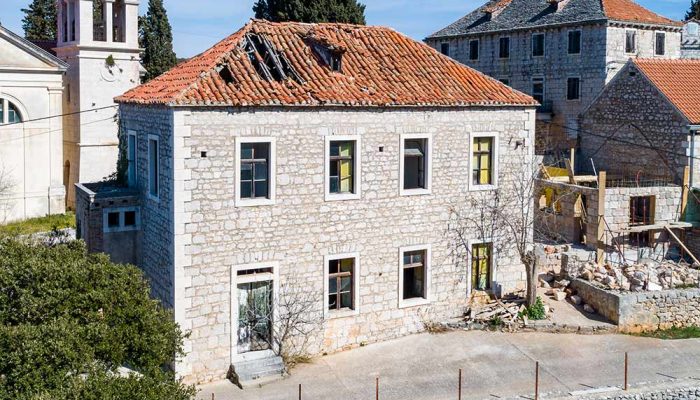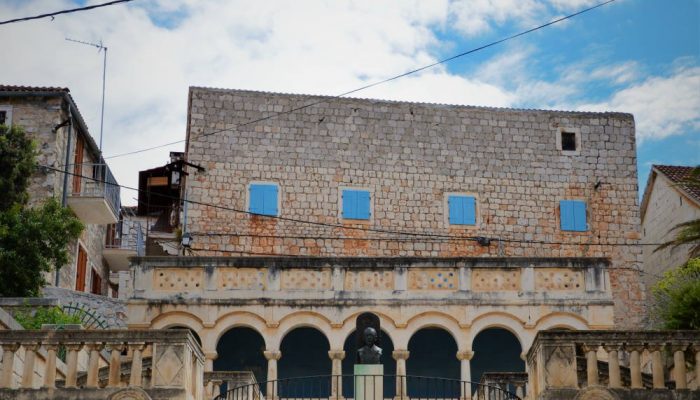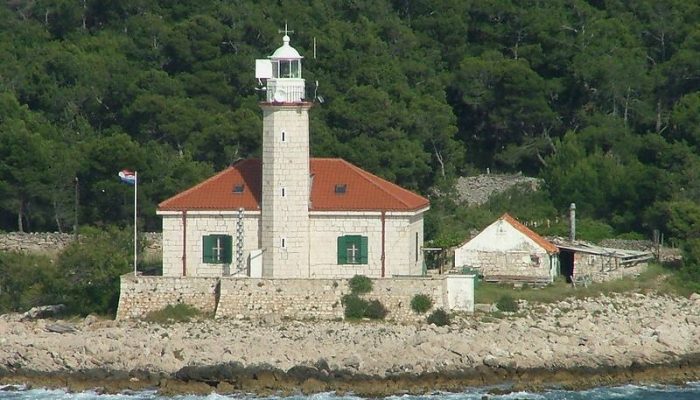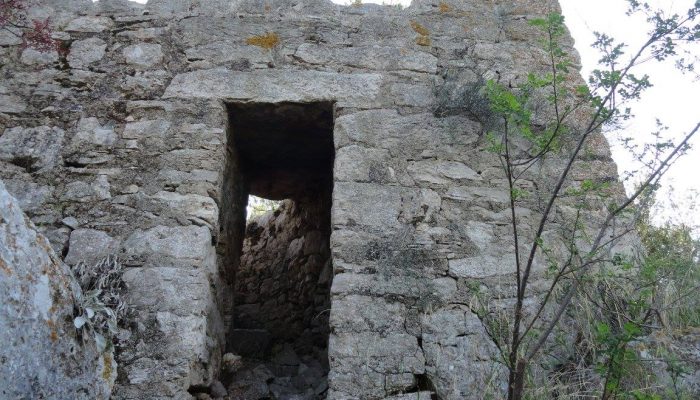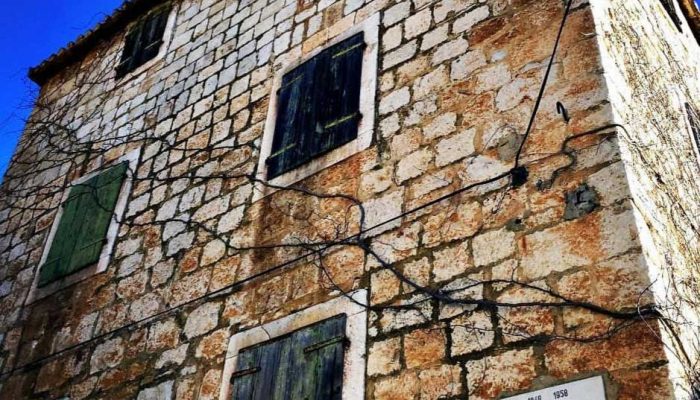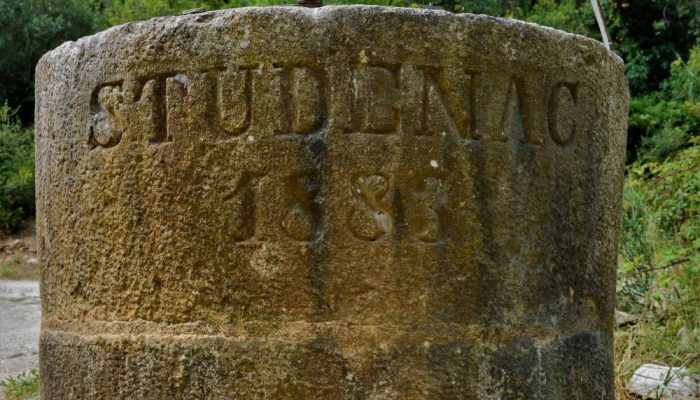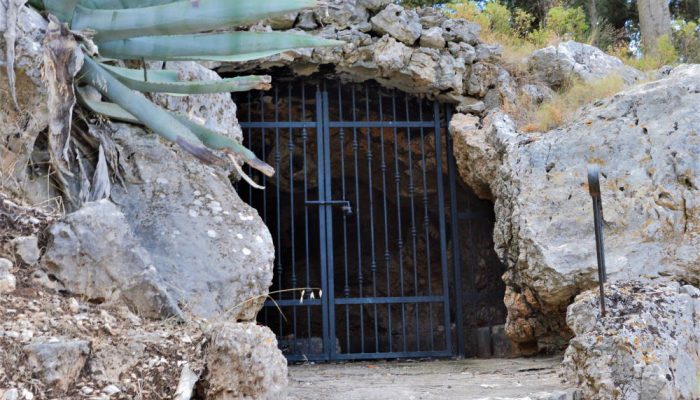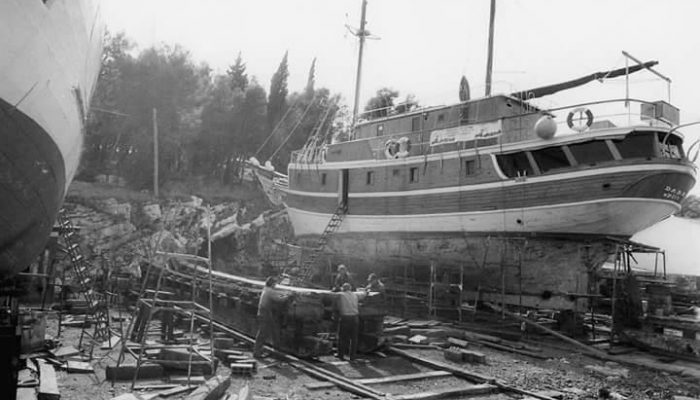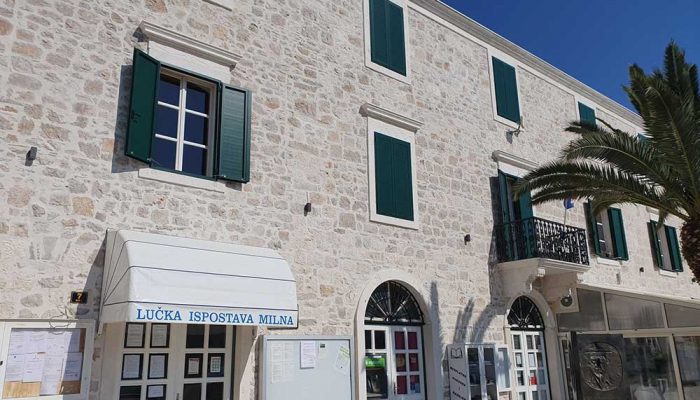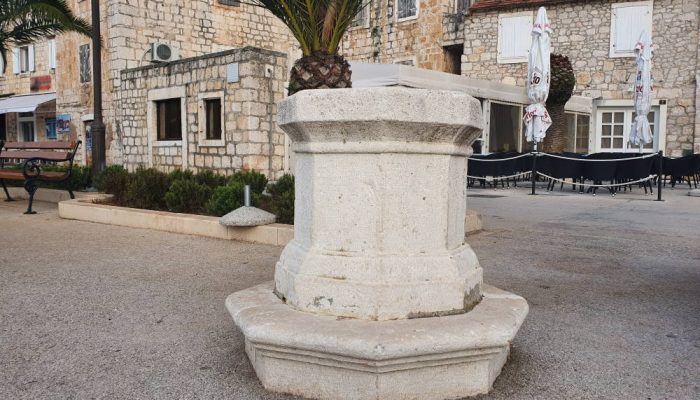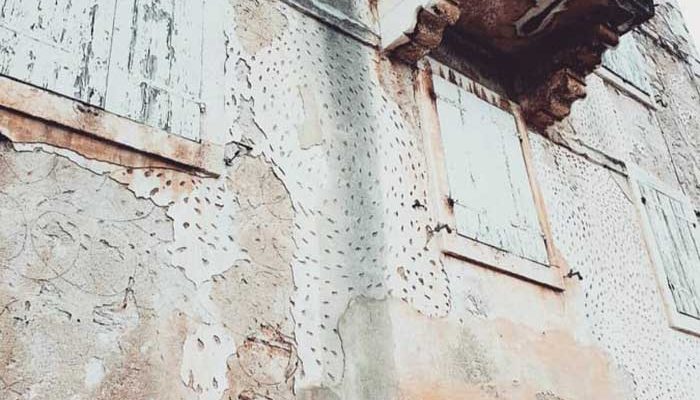Vladimir Nazor House
Vladimir Nazor House is located on the northern side of the Bobovišća harbor. The three-house complex consists of ground, first floor and the loft. The latter features several dormers which align with the windows on the first floor. There are two stone staircases, one on each side of the houses. Between 1933 and 1937 central part of the house was remodeled, which changed its original design. Part of the original interior was kept, including some furniture, books and photographs. The 19th century complex is characterized by ambient value of residential architecture and is also a memorial to the great Croatian poet who spent part of his childhood here. Close to the house is the statue of Vladimir Nazor himself.
The Nazor House and the complex surrounding it are protected as cultural heritage of the Republic of Croatia.
Gligo Castle
The Gligo Castle is located on the shady side of the Bobovišća bay. Its large courtyard is surrounded by the three wings of the castle and a large defensive wall to the sea. The top of the defense wall holds remains of a walkway. To the east, a square two-storey building stands out from the closed courtyard with several loopholes on the ground floor. It belonged to the Baroque section of the fortification. The oldest, southern part of the castle holds several defensive elements, as well as Baroque dormers in the attic. Marinčević-Gligo family emerges in the late 17th century. Their castle is a valuable Baroque fortification, at the time important for the defense of the harbor, as well as the interior of the island. Gligo Castle is a protected cultural heritage of the Republic of Croatia.
Three Sisters (Bobovišća na Moru)
The Three Sisters Tower is a symbolic tower made up of three concrete columns and a frieze built by Vladimir Nazor in 1937. The columns are engraved with the letters I, O, A – the initials of Irma, Olga and Amalia, the sisters he had taken care of all their lives.
Simbolic Tower (Bobovišća na Moru)
The symbolic tower was built by Vladimir Nazor using gathered rocks.
The Cerinić Gligo House (Bobovišća)
The Cerinić-Gligo House is located on the west side of the village, towards the Bobovišća harbor and represents architecture of late Baroque Classicism. This impressive three-storey building with a high attic was built in the first half of the 19th century in the middle of a spacious garden. It was built using large stone blocks in even rows, with five windows on the longer side and two on the narrow side of the house. The Gligo House is an architectural monument and one of the finest examples of architecture of its time.
The Cerinić-Gligo House is a protected cultural heritage of the Republic of Croatia.
Stone Bridge (Ložišća)
The Stone Bridge is located in a deep ravine leading from the Ložišća field to Vičja luka, through which torrential streams used to pass. The bridge was built during the Austrian rule and is a kind of oddity on what is now a waterless island. Locals affectionately call it the Franz Joseph bridge. It is considered to be a technical rarity as well as a monument to 19th century engineering.
The Stone Bridge is a protected cultural heritage of the Republic of Croatia.
Parish House and First School
In 1857 the Parish House building and the First School were built. This three-storey stone house featuring three tall dormers represents a notable example of residential and public architecture of mid-19th century. Elementary school “Ložišća” was founded by the executive order of the Dalmatian Governorship in Zadar as a one-class male school. The first teacher was a priest, Don Frano Gospodnetić. In 1893, by the order of the Provincial School Board in Zadar the school was promoted to a three-class male school. The school building is the property of the “Crkvovinarstvo” (church association) in Ložišća and was built in 1857. Classrooms are on the ground floor and on the first floor, while the parish office and the parish priest’s residence can be found on the second floor. Classes were held here since 1857, until 1965 when the school closed and lower-grade students started attending the Milna elementary school.
Donji Pisk or Stara voda (Ložišća)
Donji Pisk is one of the largest rainwater collection facilities on Brač. Harvesting pools collect water which then flows via wide ramps with curbs to walled pools and stone containers used for watering livestock. This industrial installation was built in the early 19th century and serves as an example of a technical solution in cultivating agrarian landscape.
Donji Pisk is a protected cultural heritage of the Republic of Croatia.
Bobovišća n/m – Arheolological site „Vičja luka“
Underwater and land site where four prehistoric graves were discovered covered with stone slabs with multiple burials and rich grave goods (bronze, amber and glass paste jewelry, bronze and ceramic pottery, Greek gems, Greco-Illyrian helmets and greaves), most likely part of a necropolis (5th to 3rd c. BC). Judging from the grave finds, Illyrian greats buried in these graves were linked to the Greeks who inhabited Vis island at the time.
Anglišćina Castle (Milna)
The Anglišćina Castle was built by the Cerinić (Cerineo) family at the turn of the 17th century. It belongs to the Renaissance type of castle intended to defend the harbor. The Milna settlement started developing around the fortified castle in the same period, by settlers from Nerežišća. They affectionately called it Agliščina, based on the tale of an English lord who supposedly lived in it.
Ražanj Lighthouse (Milna)
The lighthouse was built in 1874 on the western tip of the island of Brač. It is composed of an octagonal stone tower and a ground floor, total area of 110m2. Rising from the center of the southern façade is a polygonal tower with a lantern at the top. Razanj Lighthouse is a cultural heritage of the Republic of Croatia.
Utvrda Baterija (Milna)
“Baterija” (The Battery) Fortification is located at Cape Zaglav and was built in 1806, during the French administration. In order to prevent the Russian fleet from invading the central Dalmatian islands, the French built fortifications and installed a battery of 4 cannons on the western Cape of Brač, and later reinforced it with 6 cannons. They commissioned 150 peasants from the island to build it because the French crew that came to Brač did not have enough people for its construction.
First School (Milna)
The first school is believed to have existed since 1834 and possibly even earlier. It was not available to everyone, only to the children from Milna’s affluent families. The school officially opened in 1848/49 as a boy’s two-year public school in a private building of the Buzolić family in an area called Pantera.
The school operated in that building from 1848 to 1882, after which it was moved to the neighboring building of the Sfarčić family, where classes were taught until 1901. Classes were held in Italian until 1890, and from April 29th 1878 Croatian language was introduced.
Polaca (Milna)
Polaca is the ceremonial loggia with a small square and stairs. It houses a bust of Ivan Bonačić- Sarga, a Milna philanthropist, who left his wealth to the town and the people of Milna.
The architect of Polaca is unknown, although it is believed it was modeled after the works of the great Croatian sculptor Ivan Rendić.
Studenac (Milna)
The Studenac (well) is today about 7 m deep, it’s narrow and built of stones from top to bottom. By all accounts, it is the first source of water in Milna since the Illyrian and Roman times. The three stones next to the draw-well were used to feed the cattle, and are fragments of early Christian sarcophagi. An early Christian cross is carved on one of them, but the origin of the sarcophagus is unknown. A long time ago the sea stretched all the way to Studenac, making it a very long cove, well protected from any enemy.
Old Shipyard (Milna)
Milna has left a significant mark on the shipbuilding history of the Adriatic region. The Golden Era of Milna was relatively short, compared to other shipbuilding towns, as most of the sail boats here were built during a twenty year period. Milna had two shipyards in the 18th century and one of them belonged to the Bonačić-Protti family. It was opened in 1750, in the Pantera area, later known as “Škver”, Dalmatian word for shipyard.
Blatačka kuća (Milna)
Monks from the Blaca Monastery achieved so much economic growth that they were able to acquire two large ships, commanded by Captain Nikolorović from Bol. Since the bay at Blaca was not suitable for a harbor, the monks built a house and warehouses in Milna, and traded and sailed the Mediterranean from there. The house can still be found at the northern end of the harbor, on the promenade that was named after them – the Blaca Riva.
Old Street Lamp (Milna)
It was installed on the waterfront in 1911 and used daily until the arrival of electricity. It is well known that madam Antula Butorović-Tošo spent her entire life as the lamplighter, up until its modernization. She carried a ladder and petroleum every day to light it. The old lantern still exists and its pedestal stands on the waterfront to this day.
Babarović Family House (Milna)
The Babarović House was the first hotel in Milna. It accommodated the first nautical tourists who did not want to sleep on their boats. It was built in 1843, to the discontent of the locals who did not like the fact that the house was big and that it obstructed the view of the parish church. They cursed the house, saying “May God strike it down, may He burn it down!”. The house survived for many years, until 2008 when there was a fire and the “Haunted House” burned down.

